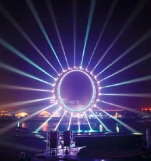Green Practices of Expo 2012

World Exhibition “Expo- 2012” - one of the largest international events of this year, took place from 12 May to 12 August in the South Korean city of Yeosu. As you could identify from the theme of “The Living Ocean and Coast”, the Yeosu Expo has the conversational topics of environmental issues like global warming and other major problems facing the planet, but it has also selected ‘green expo’ as a strategy for the success of the event.
At Expo 2012 was attended by 104 countries, along with international organizations, including the United Nations, multinational companies, as well as the Korean authorities at different levels. The exhibition was visited by more than 8 million people who consider that their visit was as memorable experience as informative and entertaining. On the bank of the Korea Strait, an area 1.74 sq. km, were hosted more than 20 pavilions and other infrastructure facilities. There were presented numerous thematic and national exposures, a variety of events.
The Yeosu Expo was designed in order to awaken and alert world citizens to the pressing issues of climate change and global warming caused by industrial activity. Emphasizing the shared impact of a damaged marine ecosystem as an issue calling for shared responsibility, the Yeosu Expo will pave the way for global cooperation in addressing these issues. The last day of the exhibition the participating countries signed the environmental “Yeosu Declaration,” which calls on governments and civil society to strengthen efforts to address environmental problems of oceans and coasts.
As the World Expo has long been regarded as one of the three pillars of international festivals, together with the Olympics and the World Cup, this year’s Expo is expected to have the largest ripple effect in the economic and cultural sectors. “Expo 2012 Yeosu Korea is estimated to earn about 12 trillion won in production and 5.7 trillion won in value-added industry, and create 79,000 jobs for the nation,” said Choi Seung-min, a researcher at the Korea Ocean Research & Development Institute. “The Yeosu Expo will present a new paradigm for encouraging the preservation and sustainable development of the vulnerable marine ecosystem.”
ICONIC STRUCTURES
Many of the exhibition objects that have become symbols of the Expo- 2012 have a long life as a tourist and entertainment attractions. Among them - the “Big O”, a theme pavilion “One Ocean”, “Sky Tower”, “Digital Gallery” and one of the world’s largest aquariums. Their creation was made possible by the use of modern methods of design and high-tech engineering solutions.
Big-O. Rising up out of the ocean at over 40 meters tall, the Big-O is a central landmark of the Expo and the main feature of the Big-O entertainment arena. Unlike common indoor performance stages, the Big-O is a cultural space that allows for performances to unfold right above the water. The circular structure, which at first glance resembles a Ferris wheel, is equipped with 56 lights, five lasers, 24 water jets, 24 flame outlets, and six projection systems. During the two-month duration of the Expo, the Big-O will be the centerpiece of a diverse array of events including fountain shows, nightly multimedia shows, and holographic projections created by the interplay of lasers and a liquid screen.
Stretching from Yeosu Expo Station to the main street of the Expo site, Expo Digital Gallery is the world’s first marine culture and arts gallery. The gallery incorporates light technology and a large 30-by- 218-meter canopy made of LED screens to create a three-dimensional underwater experience. Video images projected onto the screen will bring fairy tales and other stories to life. Several of the digital marine animals have been designed to respond to cues such as text messages and loud cheers from visitors. The Expo Digital Gallery is unique among the Expo facilities in that it gives visitors an interactive experience.
Sky Tower is the highest structure at the Expo and offers panoramic views of event grounds as well as the coast from its observation deck. An artistic masterpiece built from abandoned cement silos, Sky Tower attests to the Expo’s theme of environmental consciousness. Attached to the exterior of the tower is a pipe organ shaped like a harp and boasting a range of 80 tones. The official name of the structure, “Vox Maris” means “sound of the sea.” Living up to its name, the sounds produced by the giant organ can be heard from as far as 6 kilometers away, a feat which has earned Sky Tower a place in the Guinness World Records as the world’s loudest pipe organ. Visitors can “play” the organ through their own smart devices, and three to five performances will be held daily at Sky Tower. Internationally renowned artists, including a symphony orchestra, a Korean traditional folk ensemble, and K-pop stars, are also set to perform on the stage at Sky Tower.
Aquarium. 6,000 tons of water fills the Expo’s supersized aquarium, which houses over 34,000 marine creatures representing over 300 different species, including the rare Baikal seal and the hippocampus and leafy sea dragons. The facility also integrates IT technology to enhance the viewing experience. “We are paying close attention to all the details to make for a clean finish,” said Kang Dong-suk, chairman of the Organizing Committee for Expo 2012 Yeosu Korea. “I will promise a wonderful once-in-a-lifetime experience and memories.
Full version you can download here
 Text: Evgeny Demin
Text: Evgeny Demin


